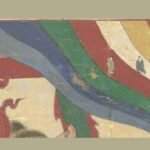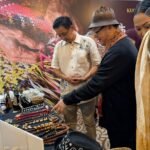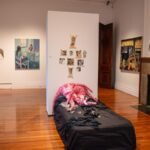
Unfortunately, a scheduling conflict prevented me from going to Vilnius on the occasion of the opening reception for The Center for the Visual Arts, which is named after one of our beloved film editors, Jonas Mekas. However, Robert Haller, the Director of Collections and Special Projects at Anthology Film Archives, was there with Jonas, and he was kind enough to left us publish a segment of his diary.
–Phong Bui
4 November 2007, Sunday
Principle figures at the Mekas Center Opening:
Jonas Mekas—poet, film-maker, advocate for independent film in his writing and in the institutions he founded (Film Culture magazine, the Film-Makers Cooperative, Anthology Film Archives, and now the Jonas Mekas Center for the Visual Arts).
Sebastian Mekas—son of Jonas, graduate student in physics (with Stephen Hawking), mathematics, languages (especially Chinese).
Adolfas Mekas—brother of Jonas. Adolfas is 93 but claims to be 98 (he is actually about ten years older than Jonas). Film-maker, sometime collaborator with Jonas. Is the retired chair of Bard College Department of Film. Is married to Pola Chapelle, a vivacious woman, and sometime curator and artist.
Benn Northover—British volunteer and vital assistant to Jonas, provides logistical support in many areas, especially on the 365 Film-a-Year web project. Always cheerful. Also helps run the www.spoolspool.com web site.
Harry and Maya Stendhal—brother and sister owners of the Stendhal gallery in NY, on the Board of Anthology, and now of the Mekas Center, great enthusiasm for Jonas and his projects.
Arturas Zuokas—former mayor of Vilnius, put his political weight and enthusiasm behind the Mekas Center, is chair of its Board.
Kristijonas Kucinskas—Director of the Mekas Center.
Rasa Razgaitis—Administrator of the Mekas Center.
Vytatus Landsbergis—first parliamentary leader of post-1989 independent Lithuania; a Fluxus artist for decades; important musical scholar, especially of Ciurlionis; now in European Parliament.
Martynas Giigas—on staff of the Mekas Center.
Pip Chodorov—American advocate for avant-garde film, operates out of Paris, contacted scores of dedicated avant-garde film people to get them to the Mekas Center opening.
Shigeko Kubota—video installation and Fluxus artist, widow of Nam June Paik.
The opening ceremonies were crowned with spectators and notables, including diplomats (China, the US, Russia) and Lithuanian government officials. Museum representation included a party from the Guggenheim in NY (headed by Tom Krens) and the Hermitage in St. Petersburg. Of course, the Stendhals, whose gallery premiered the components of the Mekas Center exhibition, and Jonas who graciously welcomed the throng. At least ten news photographers were flashing pictures through all of the introductions, and continued as the crowd looked at the graphically powerful and often puzzling Maciunas art and documents, and Jonas’ kinetic film clips and frame enlargements. Both Mekas and Maciunas are cosmopolitan iconoclasts of Lithuanian origin. Both associated with John Lennon, Yoko Ono, Jackie Kennedy, Andy Warhol.
In one side gallery was Shigeko Kubota’s classic video installation “Nude Descending a Staircase” which overtly salutes the Duchamp painting (Duchamp’s Anemic Cinema, a part of the collection of avant-garde films continually playing in the main gallery, was only one wall and a few feet away). There are other such juxtapositions.
Avant-garde art, from the beginning of the twentieth century to the current years of the twenty-first, is the focus of the Mekas Center. Prime Minister Gediminas Kirkilas has spoken of the Center as an integral part of Vilnius’ twenty-first century promotion of art. Vilnius, the capital of Lithuania, has been designated as a European “Capital of Culture for 2009.” In this initial exhibition, in addition to Mekas and Maciunas, the Center also celebrates the early twentieth century Lithuanian poet Kazys Binkis, and more broadly, the Fluxus movement. Several Fluxus artists—including Ben Vautier and Shigeko Kubota—were present at the opening. The Center is now soliciting design proposals—from architects Zaha Hadid, Daniel Libeskind, and Massimiliano Fuksas for a free-standing museum that will operate with the Hermitage and the Guggenheim.
Fluxus, the movement of which Maciunas was one of the great champions—and in which Mekas also participated—is an elusive kind of art which sought; 1) To “purge the world of dead art… abstract art, [and] illusionistic art.” But this purge does not include Duchamp’s ready-mades, or the music of John Cage, so Fluxus is tangential to but not totally outside modernism. 2) Common, everyday actions can be Fluxus art. 3) Fluxus embraces applied arts, including graphic arts (where Maciunas was an adept). 4) Fluxus is very international, not solely rooted in Europe. A leading Fluxus artist was the Korean Nam June Paik. Another was Shigeko Kubota (from Japan).
The combination of Mekas with Maciunas is more than one of national origins and friendship. Both re-worked, extended, and rethought how their media could be used in our time. Mekas has returned to many of the realistic aspects of the Lumiére films, although he uses many more stops and starts (edits, but often in camera) than the Lumiére films. The Lumiére movies were as subjective as the Mekas films, but in the Lumiéres, that element of personal choice is not as apparent (the Lumiéres did use editing and camera movement, which are often overlooked).
Maciunas challenged orthodox conceptions of modern art and remade the fundamental means of our communication—how we use the alphabet. Five hundred years ago, Gutenberg and his successors standardized the use of fonts and typography to make printed materials—books, journals, all published documents—easily readable, accessible to the public. Maciunas used combinations of fonts to create new graphic forms. See, for example, the treatment he gives to the name “Jonas Mekas” on page 183 of the catalog.
Also attending were most of the Mekas family in Lithuania, and two nieces of Maciunas, all of whom I photographed in one large group that was organized by Pola Chapelle. There were a lot of cameras in evidence, but only Martina Kudlacek and I were doing systematic coverage, Martina in video, myself on b&w still film.
The level of public visibility cannot be exaggerated. Jonas was on the front pages of all the Vilnius newspapers on Monday, and his face looked out of the sides of many public transit buses.
The catalog for the exhibition is an important document not only about Fluxus, but also for its examinations of Mekas’ cinema (by film-maker/ scholar R. Bruce Elder) and a personal profile of Maciunas (by Hollis Melton).
After an hour and a half in the gallery, we all moved to an adjacent restaurant for drinks, snacks and Fluxus performances (the sound of crumpling newspapers, periods of silence, ritual acts, etc). At about 3:30, Martina and I returned to our hotel rooms.
There I discovered that Arte was cable-casting an exceptionally good production of Wagner’s Parsifal. Soon after the wandering knight asks (at last!) “What is the Graal?” he and Guernemaz are alone on the stage while rolling bars of light make it appear they are on a descending platform. Above, to stage right, is what looks like a spinning boulder, or an asteroid—seeming to answer Parsifal’s question. As a pre-Christian image, this mineral-Graal was breathtaking, a vision I have never seen before.
At 6, Henry Hills, Martina, and I took another cab to the Skalvija theater where Jonas was introducing a program of classic avant-garde films to a sold-out audience of young people (Rhythmus 21, Ballet Mecanique, Anemic Cinema, un Chien Andalou, Arnulf Rainer, and Lights by Menken). There I learned of an un-announced 7:30 dinner with Prime Minister Gediminas Kirkilas. So Jonas, Sebastian, Harry, Maya, Benn, myself, and some 12 others departed in official cars to a meal for twenty-two.
Jonas sat facing the Prime Minister. We all had designated seats. I was on a corner, with Adolfas, Ben Vautier, Rasa, and Landsbergis on my left, and Harry, Sebastian, Benn, and the PM on my right. Apart from some short toasts, there were no formal speeches—but there was ceaseless talk (Harry said he liked my review of Bill Morrison’s show at the Stendhal Gallery; Vautier was mildly contentious about politics; Adolfas was amusing and kept Vautier in check). When the desert was served, Landsbergis, at Jonas’s suggestion, played a Ciurlionis composition on the piano. Jonas had been praising Ciurlionis as the first modern artist in Lithuania—and Landsbergis is the foremost scholar of Ciurlionis (and was the first PM of the free Lithuanian Parliament after the soviets retreated in 1989). Of course, with my camera, I photographed Jonas filming Landsbergis. After the dinner we returned to the hotel, where I caught the end of Kubrick’s 2001: A Space Odyssey, and noticed that the broken wine glass episode in the Louis XIV suite seemed a borrowing from Maya Deren’s Meshes of the Afternoon.
5 November 2007, Monday
Returned to the Mekas Center to pick up copies of the catalog. As I sat looking at it, Maya came up to ask what I thought of it, but I said it was the first time I had a chance to look through it (yesterday my camera left me no free hands for anything else). It was her first chance too, and she winced at some of the cross-gutter layouts. Tomorrow she had to fly back to Manhattan to hang the next gallery show. When I got back to the hotel I discovered that Henry and Martina had already departed (to Prague and Vienna). Benn tells me there is another dinner at Stickley’s tonight. Before this I wander through the neighborhood, buy an Amber egg for Amy, a small pyramid for myself. At the dinner I sit with Julia, Sabrina (I photograph them, and Maya against a rough wall with a lamp mounted on it) and feebly attempt to shoot the rest of the table, but the light is so low. Others at the table are Jonas, Tom Krens, Sebastian, Adolfas, Pola, Harry, the Russian Curator from St. Petersburg, Arturas Kristijonas, August, and some others. Food was very good (it always was); I had some kind of fish. Adolfas gave me a Vitruvian Man medal his son has made. We move on to an Irish bar where the festivities continue. At 11:30 I leave to go back to the hotel, but the others go on to another bar, where Jonas gets into a brawl with some character who questions his Lithuanian patriotism. I learn of this the next day.
6 November 2007, Tuesday
This morning I decide to try to get my five rolls of exposed film developed and contact printed in Vilnius, at one of the four labs in the city. But because of equipment breakdowns, none can do it this week. I manage to walk across town without getting lost, but find no functioning lab. On my way to the last store, an Agfa firm, I suddenly hear a voice shouting “Robert Haller!” It is Benn who was in a cab with Adolfas and Pola. He jumped out to catch me on the street (astounding that our paths would cross in this large city). Together we go to the Agfa store, but they can only develop, not contact print, so I give up, and go with Benn to the center where I hand the film to Arturas who says he will have the film developed, scanned, and returned to me. Pola and Adolfas leave for the hotel (they are returning to the US), but Benn, Arturas, Jonas, Sebastian, and then I travel to a Lithuanian Ministry where Jonas is getting a new passport (expedited by the PM). I photograph the procedure, and we all retire to a nearby restaurant to celebrate. Jonas requests a special wine, then tells me I must sip it. After 27 hours of refusing, I accede—and he films the epochal event. I still don’t like the taste, add lemon to the red wine (to the horror of everyone else) but it still tastes vile.
Then we go to Stickley’s again, with a somewhat different group: Jonas, Benn, Sebastian, Giuseppe, the parents of Julius Ziz, Arturas, Kristijonas, Rasa, and a couple of local politicians. On Jonas’s recommendation I get dumplings, but they disappoint, and I loudly say that Amy’s mother made better ones. Jonas and Benn are returning to New York and London the next day, so this dinner adjourned earlier. Before that, Jonas points to me, tells Arturas that I am a scholar deeply involved with King Arthur. This led to my assertion that the Arthur story was enduringly interesting because it dealt with love, reason, and politics—an unstable combination. Jonas replied, asking why I said such a serious thing at the dinner, and I said he implicitly urged me to explain the importance of Arthurian literature. I was sitting next to Sebastian, and he liked the difference between zero and nothing—this was quite different in tone from the enthusiastic Lithuanian folk singing led by Jonas and Julius’s parents.
7 November 2007, Wednesday
Snow. The streets and sidewalks all covered with half an inch. I walk back to the Mekas Center, going by the KGB Museum which is ringed with the names of thousands of Stalin’s victims, all incised into the marble base, all followed by end dates of 1945, 1946, and 1947. History endures here.
8 November 2007, Thursday
I pack with difficulty, board a Lithuanian Air flight # TE 0480 to Brussels. The meal was dull, the first really disappointing Lithuanian meal in a week.
In the perspective of 2007 the opening of the Mekas Center is another step—a major step—in the spread of American avant-garde visual culture, especially film, into Europe. Because the Mekas Center is a permanent facility, it will probably have a more lasting impact than the larger, but temporary Mindframes exhibition which began the year in Germany, and will close out 2007 in Prague.
In the case of the Mekas Center, some of its films are European in origin, but they are relatively unknown to most Europeans today (save for the limited few who attend museums like the Pompidou). For the Lithuanians and others on the Continent, this is a process of rediscovery. They welcome it, greet it with curiosity. Later this evening I attend a showing of John Smith’s witty films in Brussels, in a commercial theater. The audience audibly respond to these English films which somewhat resemble those of Hollis Frampton.










